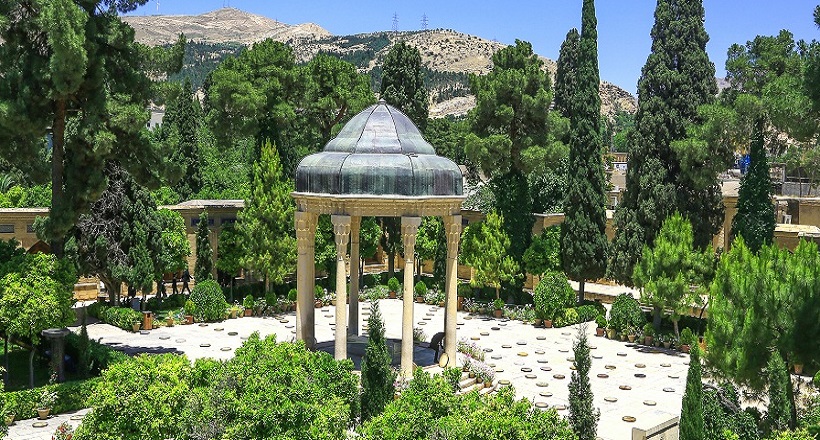

الا یا ایها الـساقی ادر کاسا و ناولـها
که عشق آسان نمود اول ولی افتاد مشکلها
O beautiful wine-bearer, bring forth the cup and put it to my lips
Path of love seemed easy at first, what came was many hardships
Hafez and His Poetry:
Hafez, born Khwaja Shams-ud-Din Muhammad Hafez-e Shirazi in 1325, is among the most celebrated Persian poets. His work, consisting of lyrical poems called ghazals, focuses on love, beauty, faith, and the mysteries of existence. Hafez’s poetry uniquely combines mysticism with a profound understanding of the human soul, addressing themes of divine love, spiritual yearning, and worldly wisdom. His approach to spirituality does not adhere to a rigid form of religion; instead, he sees the divine in all of life’s aspects and encourages readers to seek personal truth through love and open-mindedness.
Hafez’s work is considered a pinnacle of Persian literature, often compared to the works of great Western poets like Shakespeare and Goethe. Goethe, deeply influenced by Hafez’s work, even wrote a series of poems in the West–Eastern Divan inspired by him. Hafez’s poems are known for their ambiguity, allowing readers to interpret the verses in various ways, whether spiritually, romantically, or philosophically. This unique quality has earned him the title “the Tongue of the Unseen” (Lisan al-Ghayb), as his words transcend literal interpretation, leading readers on a path of introspection and discovery.
For Iranians, Hafez’s poetry is more than literature; it is woven into their cultural fabric. His Divan (a compilation of his poems) is consulted similarly to a book of proverbs, used for guidance and inspiration. The practice of fal-e Hafez (Hafez reading), where people open his Divan randomly to find answers to questions or gain insight, is a common tradition in Iran, especially during special occasions like Nowruz and Yalda Night.
The Tomb of Hafez (Hafezieh):
Hafez is buried in his birthplace of Shiraz, a city known for its rich cultural heritage and scenic gardens. His mausoleum, called Hafezieh, is a tranquil site nestled in a beautiful garden that reflects the essence of his poetry. Constructed initially in 1452 and modified several times since then, the current structure was designed by the French architect André Godard in 1935. The tomb is situated beneath a pavilion with a dome shaped like a dervish’s hat, symbolizing Hafez’s connection to mysticism and spiritual depth. The dome is adorned with intricate tilework in colors of blue, green, and gold, which symbolize the night sky and the divine.
Visitors to Hafezieh often find a sense of peace and connection as they walk through the gardens, read his poems inscribed around the site, or sit near the tombstone, which features a famous ghazal by Hafez. The presence of roses, cypress trees, and fountains around the tomb adds to the serene atmosphere, embodying the imagery found within his poetry.
For Iranians and international admirers alike, Hafezieh is not just a burial place but a pilgrimage site where people come to honor Hafez’s legacy, reflect on his wisdom, and perhaps even find answers to their own life’s questions through fal-e Hafez. The tomb of Hafez stands as a timeless tribute to a poet whose words have crossed centuries, inspiring generations to explore the depth of love, freedom, and the human spirit.